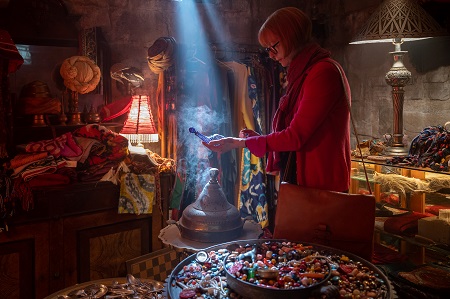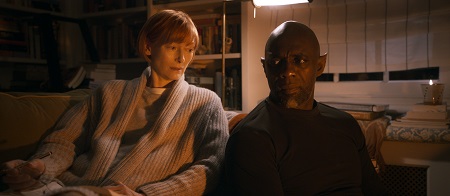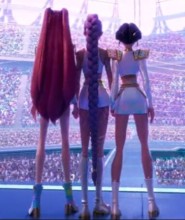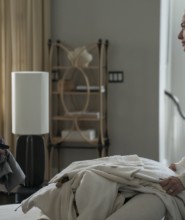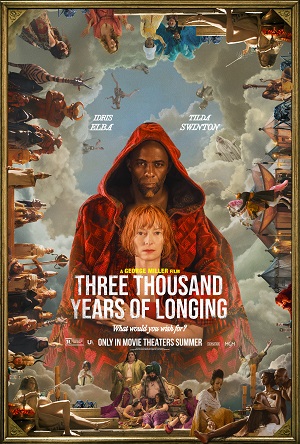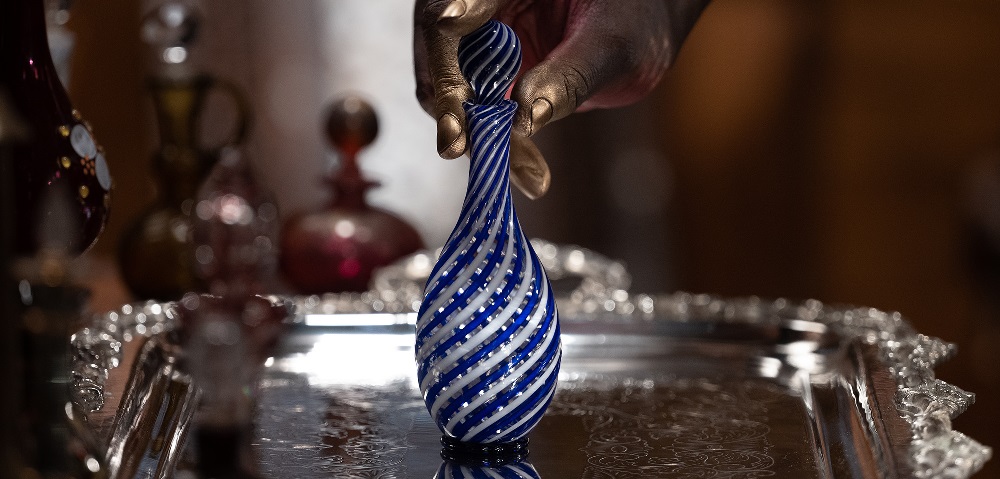
Three Thousand Years of Longing (2022)
by Sara Michelle Fetters - August 26th, 2022 - Four-Star Corner Movie Reviews
George Miller’s Fearless Three Thousand Years a Romantic Dream Come True
While the Mad Max series has understandably come to define his cinematic legacy, Academy Award-winner George Miller is far from being a one-trick pony. He’s also the warped, undeniably fearless mind behind films as diverse as The Witches of Eastwick, Lorenzo’s Oil, Happy Feet, and Babe: Pig in the City. The filmmaker goes for broke each time he steps behind the camera, and you can immediately feel how much of himself he has put into his productions within the first handful of minutes.
This goes for Miller’s latest flight of exuberant fancy, the masterfully immersive adult romantic fantasy Three Thousand Years of Longing. A dynamic, blatantly melodramatic spin on storytelling, loss, aging, and love, it analyzes “be careful what you wish for” in playfully minute detail, but does so in a way that also dissects the situational irony that lies at the center of the quote.
And yet, Miller also stays true to his two primary characters, never belittling or undermining them just for the sake of a cheap joke, an unexpected thrill, or a sensationalistic jolt of emotional hokum. While the director’s latest is unabashedly romantic, it similarly refuses to be mushy. The picture proudly wears its heart on its sleeve — imperfections, wounds, scars, and all — and in doing so allows Miller to craft a timeless spectacle of human understanding that’s one of best of its kind I’ve seen in years, maybe even decades, maybe ever.
Dr. Alithea Binnie (Tilda Swinton) is a student of story. She dissects tales as old as Beowulf and as current as the latest cheap dime store mystery in a never-ending attempt to unearth the connective tissue that has allowed humankind to document its messy history throughout the centuries. In Istanbul for a conference, Alithea discovers a dirty blue glass bottle in a random antique shop. Although it’s unlikely to be of any value, it piques her interest, and the academic eagerly takes it back to her hotel in the hope of deciphering aspects of the object’s story, no matter how mundane they may prove to be.
The bottle is anything but that, however. Inside, trapped for eons, is a djinn (Idris Elba), and he requires Alithea to make three wishes born from her heart’s desire to finally achieve his freedom. But as a scholar, this is one piece of storytelling mythology she is intimately acquainted with. Wishes never work, and no matter how fond she grows of the djinn and would like to help him, Alithea is hesitant to do what he asks, knowing things will undoubtedly go wrong if she does.
Based on British author A.S. Byatt’s 1994 short story The Djinn in the Nightingale’s Eye, Miller and co-writer Augusta Gore’s screenplay dreams big, attempting to showcase fantastical anecdotes of tragedy, longing, and love spanning the course of multiple millennia. The djinn recollects all three times he was trapped inside of a bottle, each a cautionary tale showcasing an aspect of the human condition that confirms the lengths people go to in their attempts to make lasting connections, right along with the varying missteps that all too frequently transpire.
Almost all of the dialogue happens inside Alithea’s hotel room, with Swinton and Elba verbally dueling in fluffy white bathrobes while sipping tea. This does not mean this is a staid, theatrically stage-bound production or a thinly veiled My Dinner with Andre retread crossed with One Thousand and One Nights. Miller has veteran director of photography John Seale treat this small, enclosed space as if it were the wide, golden-hued endless deserts the latter brought to vivid life in The English Patient and Mad Max: Fury Road. There is a majesty to how the actors are framed, and while the djinn is a giant and Alithea far more diminutive in stature, the pair slowly become physical equals as the day becomes night and one fanciful recollection bleeds into another.
Then there are the djinn’s stories themselves. Each is an explosion of movement, life, and color, yet none look or feel the same. They have a distinct aesthetic that makes them easy to separate, yet the connective tissue utilized by production designer Roger Ford (Babe), supervising art director Sophie Nash (The Nightingale), costume designer Kym Barrett (The Matrix), set decorator Lisa Thompson (The Dressmaker), and the film’s talented makeup team to link them together remains seamless.
But this technical perfection would mean nothing without the human element, and there Miller does not disappoint. Swinton and Elba have divine chemistry, and the growing affinity between their characters throughout this long conversation happens with eloquent naturalism. Both Alithea and the djinn have been hurt, and this pain has taken root deep inside their souls, almost to the point they’ve each forgotten it exists.
Swinton and Elba burst this bubble, allowing these emotions to morph into something fresh, unexpected, and hauntingly new. The pair are extraordinary. Because of this, the climactic turn of events hit me like a magically ethereal freight train, the tears I shed appearing with such sudden authenticity that I didn’t have time to reach for a tissue before my shirt collar was soaked.
Miller takes big swings, and not all of them connect. There are points where elements come off a bit silly, and others just linger to the side, as if hoping they’ll somehow get tied into the bigger picture before they fade away into nothingness. It’s as if the director doesn’t know how to rein himself in, and there are moments of weird obnoxiousness that stand out for reasons I have difficulty believing were planned.
I say so what, though, as I easily could be wrong about all of that. None of these nitpicks matter. Miller maintains such a firm grasp on what he’s saying and where he wants to go that even the pieces of Three Thousand Years of Longing that do not fit in this metaphorical romantic puzzle end up feeding into a larger narrative of what it means to be human and the unfathomably obtuse convolutions that tie everyone together. It is the story of life, and as frustrating and maddening as that can be, it’s also quite beautiful: the continual hope for a better tomorrow is a wish worth making, no matter what the risks.
– Review reprinted courtesy of the SGN in Seattle
Film Rating: 4 (out of 4)

